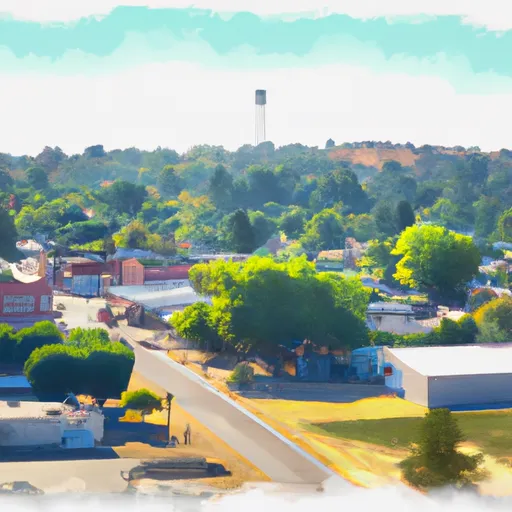-
 Snoflo Premium
Snoflo Premium
Get unlimited access to all our content
With no Ad interruptions! - Start Your Free Trial Login with existing account
Raymond
Eden Index
Climate
9.1
•
Recreation
2.6
•
Community
1.9
•
Safeguard
5.0/10

Raymond, California is a small unincorporated community located in Madera County. This picturesque area is characterized by its pleasant Mediterranean climate, with hot and dry summers and mild, wet winters. Temperatures range from an average high of 92°F (33°C) in July to an average low of 41°F (5°C) in January.
Hydrologically, Raymond is situated in the foothills of the Sierra Nevada Mountains and is fed by several nearby rivers and streams. The most significant water source is the Fresno River, which provides scenic beauty and opportunities for water-based activities.
Outdoor recreation opportunities abound in Raymond and its surrounding areas. The Sierra National Forest, encompassing over a million acres, offers an array of activities such as hiking, camping, fishing, and wildlife viewing. Additionally, the nearby Yosemite National Park is famed for its stunning landscapes, including granite cliffs, waterfalls, and ancient sequoia trees.
In conclusion, Raymond, California is blessed with a pleasant Mediterranean climate, access to waterways, and abundant outdoor recreation opportunities. Whether visitors are seeking leisurely activities or thrilling adventures, this beautiful area has something to offer for everyone.
What is the Eden Index?
The Snoflo Eden Index serves as a comprehensive rating system for regions, evaluating their desirability through a holistic assessment of climate health, outdoor recreation opportunities, and natural disaster risk, acknowledging the profound impact of these factors on livability and well-being.
Climate Health Indicator (CHI): 9.1
Raymond receives approximately
401mm of rain per year,
with humidity levels near 73%
and air temperatures averaging around
17°C.
Raymond has a plant hardyness factor of
9, meaning
plants and agriculture in this region tend to thrive here all year round.
By considering the ideal temperature range, reliable water supplies, clean air, and stable seasonal rain or snowpacks, the Climate Health Indicator (CHI) underscores the significance of a healthy climate as the foundation for quality living.
A healthy climate is paramount for ensuring a high quality of life and livability in a region, fostering both physical well-being and environmental harmony. This can be characterized by ideal temperatures, reliable access to water supplies, clean air, and consistent seasonal rain or snowpacks.
Weather Forecast
Streamflow Conditions
San Joaquin
Area Rivers
San Joaquin
Snowpack Depths
San Joaquin
Reservoir Storage Capacity
San Joaquin
Groundwater Levels
Recreational Opportunity Index (ROI): 2.6
The Recreational Opportunity Index (ROI) recognizes the value of outdoor recreational options, such as parks, hiking trails, camping sites, and fishing spots, while acknowledging that climate plays a pivotal role in ensuring the comfort and consistency of these experiences.
Access to outdoor recreational opportunities, encompassing activities such as parks, hiking, camping, and fishing, is crucial for overall well-being, and the climate plays a pivotal role in enabling and enhancing these experiences, ensuring that individuals can engage in nature-based activities comfortably and consistently.
Camping Areas
| Campground | Campsites | Reservations | Toilets | Showers | Elevation |
|---|---|---|---|---|---|
| Mariposa Fairgrounds | None | 1,855 ft | |||
| Bagby Rec Area | 30 | 862 ft | |||
| McCabe Flat | 3 | 1,131 ft | |||
| Dirt Flat | 5 | 1,723 ft | |||
| Indian Flat | None | 1,663 ft | |||
| Jerseydale | 10 | 3,676 ft | |||
| Codorniz Rec Area | 62 | 742 ft | |||
| Hidden View | 55 | 566 ft | |||
| Railroad Flat | 6 | 1,070 ft |
Nearby Fishing
Nearby Ski Areas
Catastrophe Safeguard Index (CSI):
The Catastrophe Safeguard Index (CSI) recognizes that natural disaster risk, encompassing floods, fires, hurricanes, and tornadoes, can drastically affect safety and the overall appeal of an area.
The level of natural disaster risk in a region significantly affects safety and the overall livability, with climate change amplifying these risks by potentially increasing the frequency and intensity of events like floods, fires, hurricanes, and tornadoes, thereby posing substantial challenges to community resilience and well-being.
Community Resilience Indicator (CRI): 1.9
The Community Resilience Indicator (CRI) recognizes that education, healthcare, and socioeconomics are crucial to the well-being of a region. The CRI acknowledges the profound impact of these elements on residents' overall quality of life. By evaluating educational resources, healthcare accessibility, and economic inclusivity, the index captures the essential aspects that contribute to a thriving community, fostering resident satisfaction, equity, and social cohesion.

